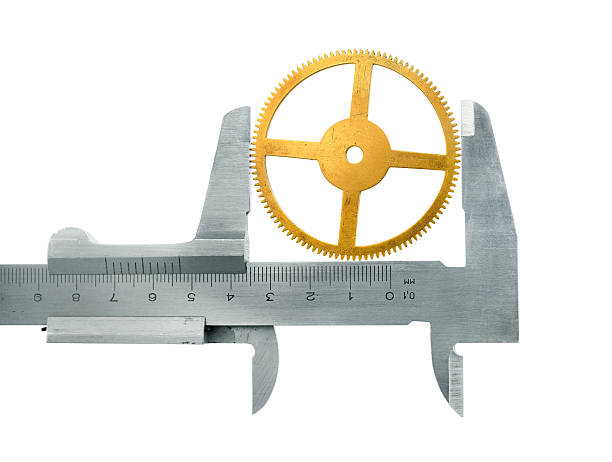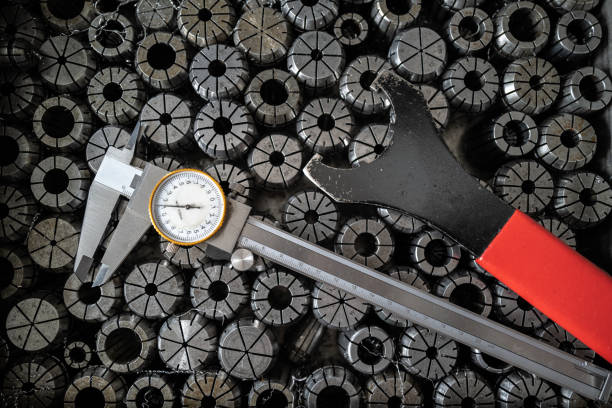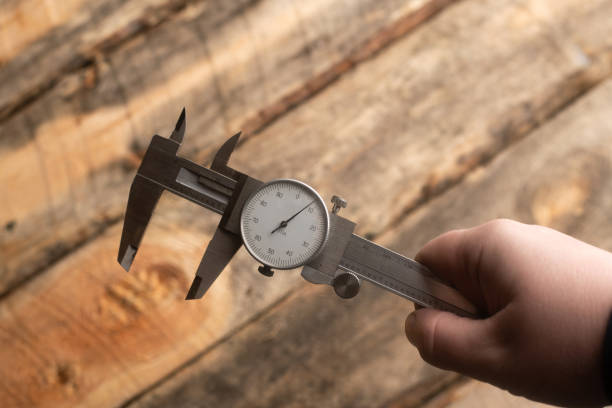Introduction
A Vernier caliper is a precision measuring instrument that is widely used in a variety of fields including engineering, metalworking, and woodworking. It is designed to provide highly accurate measurements of length, depth, and diameter of an object. The Vernier caliper is a versatile tool that can be used to take both basic and advanced measurements with ease.
The Vernier caliper consists of a main scale and a vernier scale. The main scale is fixed and is used to measure the overall length of an object, while the vernier scale, which is movable, is used to measure the fractional part of an inch or millimeter. The vernier scale is divided into smaller divisions than the main scale, allowing for more precise measurements.
Accurate measurements are crucial in many fields and industries, and a Vernier caliper is an essential tool for achieving this level of precision. It is important to learn how to properly use and read a Vernier caliper to ensure accurate measurements and avoid errors.
In this blog post, we will go over the basic components of a Vernier caliper, explain how to take basic measurements, and provide tips and tricks for advanced measurement techniques. We will also cover the proper maintenance and care of your Vernier caliper to ensure it continues to provide accurate measurements for many years.
Understanding the Parts of a Vernier Caliper
Before using a Vernier caliper, it is important to understand the different parts and how they function. The main components of a Vernier caliper include:

- Fixed jaw: This is the stationary part of the caliper that is used to measure the outside diameter of an object.
- Movable jaw: This is the part of the caliper that can be adjusted to measure the inside diameter of an object.
- Main scale: This is the large scale that is fixed to the caliper body, it is used to measure the overall length of an object.
- Vernier scale: This is the smaller scale that is attached to the movable jaw, it is used to measure the fractional part of an inch or millimeter.
- Locking mechanism: This is used to lock the movable jaw in place for taking measurements.
It’s also important to note that Vernier calipers come in both inch and millimeter measurements, make sure you use the right one for your project.
Understanding how these different parts work together will make it easier to take accurate measurements with your Vernier caliper. Practice using the caliper and become familiar with how the vernier scale lines up with the main scale, this will make it easier to read the measurements correctly.
Taking Basic Measurements
Once you have a good understanding of the parts of a Vernier caliper and how they function, you can begin taking basic measurements. Here is a step-by-step guide on how to take some of the most common measurements with a Vernier caliper:

To read a Vernier caliper, follow these steps:
- Make sure the Vernier caliper is set to zero by rotating the adjustment knob if necessary.
- Take the measurement by either using the inside jaws to measure the inside diameter of an object, the outside jaws to measure the outside diameter of an object, or the depth probe or rod to measure the depth of a hole or groove.
- Carefully adjust the jaws or probe/rod until they are snug against the object without applying too much pressure.
- Read the measurement on the main scale and vernier scale, and add the two values together to get the final measurement.
- To read the vernier scale: Look at the main scale and find the number that lines up with a line on the vernier scale. The number on the vernier scale that lines up with the main scale represents the fraction of the smallest division on the main scale.
It’s important to practice using a Vernier caliper to become more familiar with how to read the measurements correctly. Additionally, it’s important to always follow the manufacturer’s instructions and consult additional resources such as tutorials, videos and instruction manuals.
Heres how some basic measurements can be taken with a Vernier Caliper:
- Measuring the inside diameter of a cylindrical object:
- First, make sure the vernier scale is set to zero by rotating the adjustment knob if necessary.
- Open the jaws of the caliper by turning the adjustment knob and place the inside jaws around the object being measured.
- Carefully adjust the jaws until they are snug against the object, making sure not to apply too much pressure.
- Read the measurement on the main scale and vernier scale, and add the two values together to get the final measurement.
- Measuring the outside diameter of a cylindrical object:
- First, make sure the vernier scale is set to zero by rotating the adjustment knob if necessary.
- Open the jaws of the caliper by turning the adjustment knob and place the outside jaws around the object being measured.
- Carefully adjust the jaws until they are snug against the object, making sure not to apply too much pressure.
- Read the measurement on the main scale and vernier scale, and add the two values together to get the final measurement.
- Measuring the depth of a hole or groove:
- First, make sure the vernier scale is set to zero by rotating the adjustment knob if necessary.
- Open the jaws of the caliper by turning the adjustment knob, and place the probe or depth rod into the hole or groove.
- Carefully adjust the probe or rod until it reaches the bottom of the hole or groove.
- Read the measurement on the main scale and vernier scale, and add the two values together to get the final measurement.
It’s important to note that accuracy is key when taking measurements. Zero the Vernier caliper before taking any measurement, and make sure the jaws are snug against the object without applying too much pressure to ensure the most accurate readings.
In addition, take multiple measurements to ensure the consistency of your readings, and make sure to use the right part of the vernier scale to read your measurements.
Advanced Measurement Techniques
Once you are comfortable with taking basic measurements with a Vernier caliper, you can move on to more advanced techniques. Here are a few examples:

- Measuring threads: To measure the pitch of a screw thread or the depth of a thread, use the depth probe or rod and carefully insert it into the thread. Adjust the probe or rod until it is at the bottom of the thread and take the measurement.
- Measuring small parts: To measure small parts, use the inside jaws of the Vernier caliper. Carefully place the jaws around the object and adjust them until they are snug without applying too much pressure. Take the measurement.
- Measuring small depths: To measure small depths, such as those of grooves or notches, use the depth probe or rod. Carefully insert the probe or rod into the groove or notch and adjust it until it reaches the bottom. Take the measurement.
It’s important to be patient and take your time when measuring small or complex parts and to practice your skills to get more familiar with the Vernier caliper.
It’s also important to remember that Vernier calipers are precision instruments and must be handled with care. Avoid dropping or striking the caliper as it can damage the internal components and cause incorrect readings.
Keep in mind that it’s important to follow the manufacturer’s instructions, as different Vernier calipers may have slightly different features or functions.
Maintenance and Care of a Vernier Caliper
To ensure accurate measurements and prolong the life of your Vernier caliper, it is important to properly care for and maintain the instrument. Here are a few tips:

- Cleaning: Wipe the caliper with a clean, dry cloth to remove any dirt or debris. If necessary, use a mild detergent and water to clean the caliper. Be sure to dry the caliper thoroughly before using it again.
- Storage: When not in use, store the Vernier caliper in a dry, clean place, away from extreme temperatures and humidity. Avoid storing the caliper in a toolbox or other container where it may be subjected to impact or pressure.
- Calibrating: Calibrate your Vernier caliper regularly to ensure accurate measurements. You can calibrate your Vernier caliper using a precision master gauge or by comparing it to a known measurement.
- Checking for damage: Check for any damage or wear to the instrument before each use, if you find any damage or if the instrument is not working properly, have it serviced or repaired by a professional.
By following these simple maintenance and care tips, you can ensure that your Vernier caliper will provide accurate measurements for many years to come.
It’s important to note that different Vernier calipers may have slightly different care and maintenance instructions, so be sure to consult the manufacturer’s instructions for your specific caliper.
Conclusion

In this blog post, we covered the basics of using a Vernier caliper, including understanding the parts of the caliper, taking basic measurements, and advanced measurement techniques. We also discussed the importance of proper care and maintenance of the caliper to ensure accurate measurements over time.
To further improve your skills and knowledge, it’s recommended to practice using a Vernier caliper, and to refer to additional resources such as the manufacturer’s instructions, online tutorials, and videos. It’s also important to become familiar with the specific measurements and units of measurement used in your field of work.
Mastering the use of a Vernier caliper can greatly enhance your skills and precision in a wide range of fields such as engineering, metalworking, and woodworking. Accurate measurements are crucial for achieving the desired results, and a Vernier caliper is an essential tool for achieving that level of precision.
Here are a few helpful links and resources for learning more about using a Vernier caliper:
- Mitutoyo Vernier Caliper Instruction Manual – This website offers instruction manuals for different types of Vernier calipers from the renowned brand Mitutoyo, which can serve as a useful guide for understanding the specific features and functions of your caliper.
- Engineering Toolbox – This website provides a detailed explanation of how to use a Vernier caliper, including diagrams and images to help visualize the different parts and measurement techniques.
- Vernier Caliper Tutorial – This video tutorial provides a step-by-step guide on how to take basic measurements with a Vernier caliper, making it a useful resource for beginners.
- How to Read a Vernier Caliper – This video provides a detailed explanation of how to read measurements on a Vernier caliper and how to take precise measurements.
- [The Complete Guide to Measuring Tools](https://www.popularmechanics.com/
